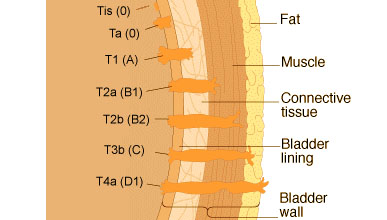Staging
Criteria for TNM Clinical Staging: Physical examination and history, histologic confirmation of tumor, bimanual examination under anesthesia, cystoscopy, urinary cytology, pyelography, imaging (radiographic and computer assisted), and other evaluations to determine metastatic involvement; lymphography (CT or lymphangiography) is required for nodal evaluation. Confirmation of extent of disease should include a biopsy deep enough to assess the depth of invasion at the base of the tumor.
Criteria for TNM Pathologic Staging: Total cystectomy and lymph node resection are required for pathologic staging.
The TNM staging system is a refinement of the Jewett system.
Comparison of AJCC and Jewett-Strong-Marshall Staging Systems
| TNM Classification | Jewett-Strong Marshall | Definition |
|---|---|---|
| Tis | 0 | Limited to mucosa, flat insitu |
| Ta | 0 | Limited to mucosa, papillary |
| T1 | A | Lamina propria invaded |
| T2a | B1 | < halfway through muscularis |
| T2b | B2 | > halfway through muscularis |
| T3 | C | Perivesical fat |
| T4a | C | Prostate, uterus or vagina |
| T4b | C | Pelvic wall or abdominal wall |
| N1-N3 | D1 | Pelvic lymph node(s) involved |
| M1 | D2 | Distant metastases |

Jewett Staging
Pathologist H.J. Jewett proposed this classification system in 1946. It was revised by Marshall in 1956, so it is also called Jewett-Marshall Staging and AUS (American Urologic System). This is a histologic staging based on depth of tumor invasion through bladder wall. Jewett's staging does not consider grade of tumor, local recurrence rate or multicentricity of tumors.
Collaborative Stage Elements
For more details on Collaborative Stage, see the Intro to Collaborative Staging module.
